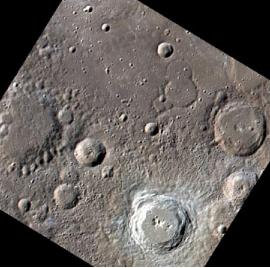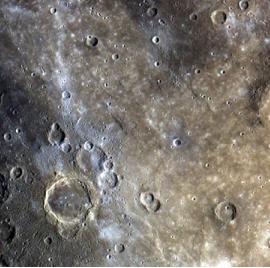More about Mercury
T
he planets were named after ancient Roman and Greek mythological gods. Mercury, the closest planet to the Sun, was identified with the Roman god who had wings attached to his feet and a helmet on his head. He swiftly delivered messages to the other gods. As the name so well implies, the planet Mercury revolves rapidly around the Sun, more swiftly than any of the others.
Mercury resembles our Moon. Like our Moon, it is small in size, pitted with craters, and has no atmosphere. Its craters were formed from a heavy bombardment of asteroids and comets during the first billion years of the solar system’s existence. The interior of Mercury, once molten, has cooled and is now solid. It is composed mostly of iron ore.
Since Mercury orbits inside Earth’s orbit, it cycles through phases like our Moon. When we see phases, we are seeing nothing more than the day and night sides of the planet at the same time.
Spacecraft
Mercury is difficult to study with a telescope because it is so close to the Sun. All of the close-up pictures of it were obtained by the two spacecraft, Mariner 10, that visited in 1975 and the more recent, Messenger that flew by in 2008 and went into orbit in 2011. Messenger has provided the greatest wealth of information and a complete mapping of the surface.

When looking at the pictures above and below, one could mistake them for the Moon instead of Mercury because the two bodies are covered in craters, have plain-type areas and are appear crystal sharp because neither has an atmosphere.
